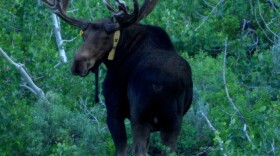A wildlife guzzler, seen in the Desert National Wildlife Refuge on a recent episode of “Outdoor Nevada” with host Connor Fields, begs the question: “Where did the animals get their water before we built the guzzler?”
The answer addresses the necessity and importance not only of wildlife guzzlers, but also of the entire DNWR. The answer, for many animals, is, “They got it at the Visitor Center.” Or it might be more accurate to say, “They got it at the big spring that has since been taken over by a homestead, and then a visitor center.”
Before humans arrived in the Las Vegas Valley, numerous natural springs, seeps, and creeks served as critical water sources for desert-adapted animals. When humans moved in, they sensibly settled next to these water sources, making them unavailable to wildlife. When the valley held a few thousand humans, a balance could be maintained. But now, as the valley has grown to more than two million, wildlife has been forced to retreat to more and more inhospitable areas — areas that don’t have the springs on which they used to depend.
The purpose of guzzlers is to give back some of what we have taken from the animals that were here before us. And that’s also the purpose of the refuge itself. DNWR serves as a stronghold against future habitat loss. We have already taken so much from these animals. DNWR is a small promise not to take any more. It’s a promise that the U.S. Fish and Wildlife Service fulfills every day, just an hour north of town.
This easy hike starts from the Corn Creek Visitor Center and offers the opportunity to learn about the abundant wildlife in the refuge. For more challenging hikes, as well as information on camping and events, visit fws.gov/refuge/desert.
Hike: Bighorn and Coyote Trails
Distance: About one mile
Equipment Needed: Ample water, comfortable shoes, and maybe a hat for the open areas of the trail. Binoculars will come in handy for wildlife viewing.
Getting There: Take US-95 North out of Las Vegas and turn right onto Corn Creek Road at the signed turnoff for DNWR. Once at the Corn Creek Visitor Center, the trail starts to the right, behind the building.
Pro Tip: Take the trails in a counterclockwise direction, and don’t be afraid to meander. The trail system stays in a reasonably confined area. Be sure to budget extra time to enjoy the Pahrump poolfish aquarium. The fish get their moniker from their playful nature, and they definitely live up to it.








